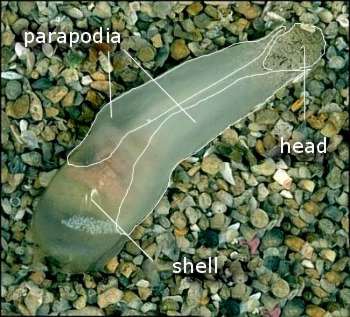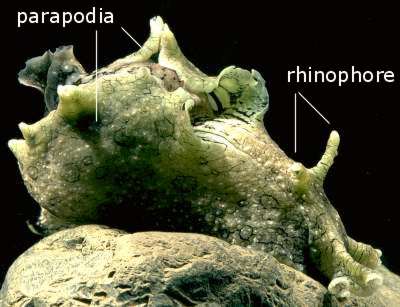

Anaspidea
Order: ANASPIDEA
PHOTO
Upper: Akera soluta showing fragile external shell, parapodial flaps and small anterior headshield [parapodia and headshield outlined in white].
Lower: A typical Sea Hare, Aplysia dactylomela, showing large parapodial flaps. Photos: Bill Rudman
The Order ANASPIDEA Fischer, 1883 [also known as the Aplysiomorpha] consists of two superfamilies, the Akeroidea and Aplysioidea, each consisting of a single family.
The Akeroidea contains a few species of the genus Akera. They are primitive opisthobranchs with an external, lightly calcified 'bubble shell' and a long elongate body modified for burrowing in soft sediments. The head region is small and they lack oral tentacles and rhinophores.
The Aplysioidea, commonly called Sea Hares, consist of 9 genera: Aplysia, Bursatella, Dolabella, Dolabrifera, Notarchus, Petalifera, Phyllaplysia, Stylocheilus and Syphonota. They range in size from species growing less than 2 cm, to large species which reach over 70 cm in length. They usually have a head bearing a pair of enrolled rhinophores, and large flattened, enrolled oral tentacles on each side of the mouth. The shell, when present, is reduced to a thinly calcified internal plate over the gill and heart. This very reduced mantle cavity is enveloped in a pair of large parapodial lobes, which in some genera are partially fused to form a secondary parapodial chamber.
Two characters common to both the Akeroidea and the Aplysioidea are the presence in the mantle cavity of an opaline gland (which secretes a colourless smelly fluid) on the floor and the purple gland on the roof (which produces a red or purple coloured ink). A third common feature is the oesophageal gizzard which contains an anterior chamber with large chitinous plates, and a posterior chamber with numerous fine spines. All anaspideans are 'herbivorous', feeding on specific algae or cyanobacteria.
Rudman, W.B., 2004 (December 22) Anaspidea. [In] Sea Slug Forum. Australian Museum, Sydney. Available from http://www.seaslugforum.net/factsheet/anaspidea
